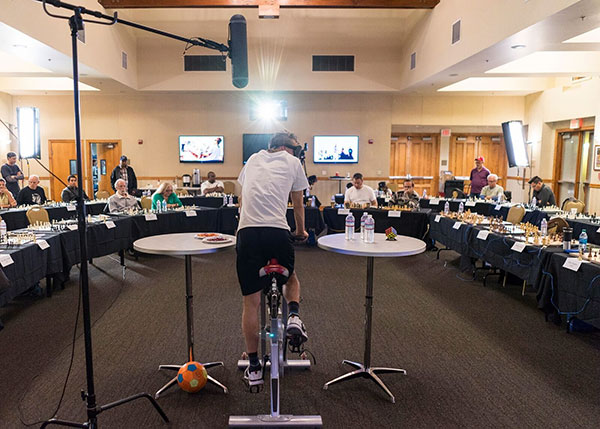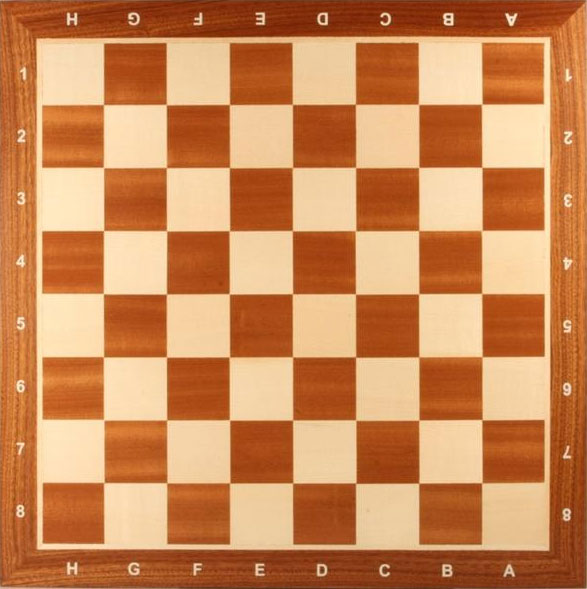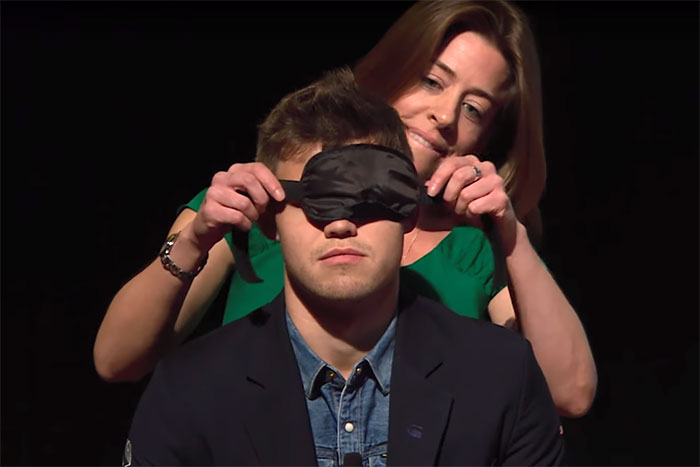Memory Techniques: the chess equation
Now that we have built a solid background by learning the memory palace and peg system techniques, we will be able to apply mnemonics to chess. But first, you may want to get yourself comfortable with the basic techniques. Like learning a new language or practicing a sport, improvement in memory techniques is a process that requires building upon, and constant training. I especially suggest that you try creating and using a numerical peg system (preferably of 100 numbers) before moving on.
Also, I am pleased to share that Timur Gareyev — the chess grandmaster whose record breaking simul inspired this series of articles — sent me an email with details of his use of mnemonics for blindfold chess. So by the end of this article, we will be able to glimpse into his use of the techniques.

Timur Gareyev during his world record breaking blindfold simul | Photo: Lennart Ootes
But first things first: if you followed the previous articles, you are aware that to achieve the best results, we have to combine the memory palace with a set of pegs. The set used will vary depending on what we are trying to memorize.
Memory Palace, pegs and chess
The application of the memory palace to chess requires no special adaptation, but we will need to create one or two distinct peg systems. As we will see, Timur only needed one for the blindfold simul. If your interest is to apply mnemonics to blindfold play or to simply develop some techniques to generally help you memorize games, you will only need one peg. However, if you want to ‘record’ whole games or several opening variants, you will need at least two distinct sets.
The simplest way to create pegs for chess is to mimic the traditional chess notation. In traditional notation, one can record a game by associating a letter (that represents the piece) and a letter/number pair that represents the square to which the piece is moving. If two distinct pieces of the same rank can move to a particular square, two letter/number pairs are used, the first representing the initial and the second the destination square.

The vast majority of chess players are extremely familiar with this notation, which is why its conversion into a peg system is relatively easy. So, just like with chess notation, we will need symbols for the pieces and symbols for the squares. For the pieces, we will need distinct pegs for the white and black king, queen, bishop, knight and rook. There is no need to have distinct pegs for the king’s pieces in opposition to queen’s. If two pieces of the same rank can both move to the destination square, the actual piece being moved can be indicated by their starting position, just as is done in algebraic chess notation.
It is also conventional to omit any symbol for pawns. If a pawn is moved, it is represented only by the destination square. So, for our first set of pegs, we will need 10 pegs for pieces and 64 for squares. That may sound like too many, but remember that memory competitors often create 100 pegs that correspond to numbers from 0 to 99.
The good news is, if you followed my advice in the last article and created a set of numerical pegs, you will be able to easily repurpose them and apply them to the board squares. The square notation uses a letter for the board’s rows and a number for the columns, so the squares go from a1 to h8. If you use numbers for both columns and rows you then have unique combinations of two digit numbers for each square (for example, a1 becomes 11, c6 becomes 36, etc). Doing that, you can directly apply your numerical pegs.
If you have no intention of creating 100 numerical pegs, you will need to create specific pegs for the chess board. That can be done by applying the major system to the number and correlating the now letter pair to some word. For example, let us do d4: in the major system, 4 corresponds to the letter R, so we have the pair ‘dr’ which could form the word ‘deer’ or ‘dare’. Now do that for all squares in the board.
If this proves too much, don’t worry. It only means you need a little more practice with mnemonics. Remember, chess memorization is very advanced, and you need to master the basics before succeeding in it.
The pieces are much easier. First, because there are fewer to remember, and second, because the ranks reflect concepts that are familiar to us. To create the piece pegs, you can use any association you prefer, but try your best to choose people as your primary images. Follow the same guidelines I explained in the Memory Palace article. Also, try to use some association (even if a loose one) between the rank and the peg.
Thus, for example, imagine you are choosing a peg for the white knight: you could think that knights ride horses, horses are fast, fast car races, so you use your favorite racer as a peg for knights. That is assuming that you like car races and have a favorite racer — remember that the association must be meaningful to you.

Ayrton Senna, one of the greatest racers of all time | Photo: Iwao (CC BY 2.0)
Finally, we will need an extra image to represent a piece being captured.
And that is it. With this set of pegs you could memorize entire games, but it can still be improved upon. Since some moves are much more prevalent than others, especially in the early game, we could save considerable space in our palaces by having pegs that represent moves, instead of pieces and squares.
Just like having 100 numerical pegs instead of 10 allows us to double the information content of each peg, by having an image for a move allow us to store the same information in half the space and time. That is particularly important in blind simuls.
Timur tells all
Let’s take a look on Timur’s email, as he presents a lot of interesting information on this topic. I’ll comment on the more relevant points:
I definitely agree establishing strong groundwork is essential for success with memory palace. Now the most important question is what the memory structure represents for the purpose of playing blindfold chess, at what stage is it essential / helpful for ultimate performance, and how to make sure the blindfold master gets to focus and refine those connections.
By far the most essential stage for practicing memory palace is the openings. There are so many beginning moves and they hardly represent much on their own until a fuller picture is shaped. The true mastery is being able to establish images in place of initial opening moves and then being able to transform those images as the game progresses.
Expert blind simuls players, like Timur, are very skilled at using unaided memory to remember complex board configurations. As Timur say, it is in the early game — when positions tend to be very similar to each other — that mistakes are most likely to occur. Hence, mnemonics were particularly useful in the beginning of his simul.

Timur Gareyev during his World Record setting 48-board Blindfold Chess Simul | Photo: Lennart Ootes
For example 1.d4 my move is Princess Diana, which the image already belongs to several destinations along my memory palace since I know I will be white and play the move on those particular boards. Now imagine games 13, 25, and 37 where I have Princess Diana at the Fountain, Campus Cafeteria, and Inauguration Speech Plaza. I receive responses 1...Nf6, 1...d5, and 1... d5 accordingly. Board 13 I have Princess Diana throwing a horseshoe into the fountain (knight move represented by a horseshoe) Board 25 & 37 I add Diana holding her hands in Namaste (symbolizing symmetric response).
Here, Timur describes some specifics of his peg system. As you can see, he associated the d4 opening with the image of Princess Diana, and since he was playing several games simultaneously, he needed an equivalent number of locations. He gives three examples: the fountain, the campus cafeteria, the Inauguration Speech Plaza. Also, he had previously decided at which games he would play d4 and so already had the Princess Diana image placed on the corresponding locations.
In order to represent the opponent’s reply, he had either an object (the horseshoe representing Nf6) or an action (the Namaste position representing d5). As he explained, the associations are very direct: knight — horse — horseshoe; and symmetry — Namaste position.

The Namaste is the traditional hindu greeting. The two hands mirroring each other represented symmetry to Gareev in his visual representation in his mind for the simul. | Photo: Saptarshi Biswas (Oberoi Employees_Rishi), via Wikimedia Commons (CC BY 2.0)
Now I have 10 out of 55 games I start with 1.d4, for each one of those specific numbers of the match, I pick a system that I would play in various cases. Now that Nf6 is played on board 13, I have decided to define it with 2.Bg5 for a clear Trompovsky set up. Along with the game number, player's voice, profile, and any extrasensory information I associate this game is well set in my mind. To make it a stronger association I may have a way to define Trompovsky by the Bishop move, which could be indicated by Princess Diana wearing a long wedding gown.
Those are very interesting details about Timur’s experiences. Associating the opponent’s voice with the game being played is a way to engage several senses into memory creation, a trick that is very powerful, especially if associated with other techniques. Also, notice how the associations can be somewhat loose: the idea of a bishop move being conveyed by a wedding gown — remember that the important thing is that the associations make sense to you.
Now as for games 25 & 37 I may choose a crazy 2.e4 sacrifice on board 25 (which will clearly define the character and maybe characterized by Princess Diana playing an explosive electric guitar in Namaste sitting position which is associated with Elvis= e4, explosive= gambit, at the cafeteria) on board 37 a classic 2.c4 may be associated with Princess Diana at the Inauguration Ceremony throwing her crown into the crowd= Queen's Gambit.
As you can tell, this could be powerful anchors if well thought through, established, and practiced proactively! Most importantly potential associations must be clearly distinguished to avoid the potential mix with so many different variations of imagery associations! Say I got my opponents moves in the games I play with black represented by animal images. For example black's 1.d4 on board 8 would be a deer at the basketball court. Which I know I will respond with 1...d5.... and so the creative process goes on!
I think that the most interesting point to take from this part is how Timur organized the pegs in order to avoid mixing the images up — by choosing the pegs for the games in which he plays with black to be animal related, he reduces the chance of any potential confusion. Moreover, notice how he tries to compile all the information in a single image. That is a risky decision (as it could allow some interference between games), but that makes sense from a cost/benefit perspective — by focusing on a single image and location per game, he can minimize the time costs of storing the peg; which is essential due to the number of games being played.
Hopefully this will give you a better insight into how the system is shaped and applied. During my last attempt I used about 30% of the process I just described to you. As I started the match, I was truly excited and overwhelmed with sensations and pressure to perform. If I started working hard on making the images work with the system I pre-planned, I would have spent a lot of energy on "completing my homework" and would have missed out on tons of sensory as well as improvised logical connections, which worked well enhancing my memory experience. After all that's how I managed to succeed with my 27, 33, and 35-game matches.
Taking the mega blindfold match game to the next level definitely entails the ability of "flying through the memory journey" and making the largely well-thought and pre-established connections. The system and the rhythm of effective memory shaping will certainly make this a truly breakthrough success via unconscious competence!
And that is the final — and possibly — most important lesson. Make sure that mnemonics is a way to achieve your goals. Don’t allow the rules to become an impediment, as they are meant to guide you, not to interfere with your progress.
That is it. With these techniques and a lot of practice you will be able to memorize any information you may need: from a poem to a chess game. All you need now is to put it into practice and make sure you have fun while doing it.
Previous articles:




























